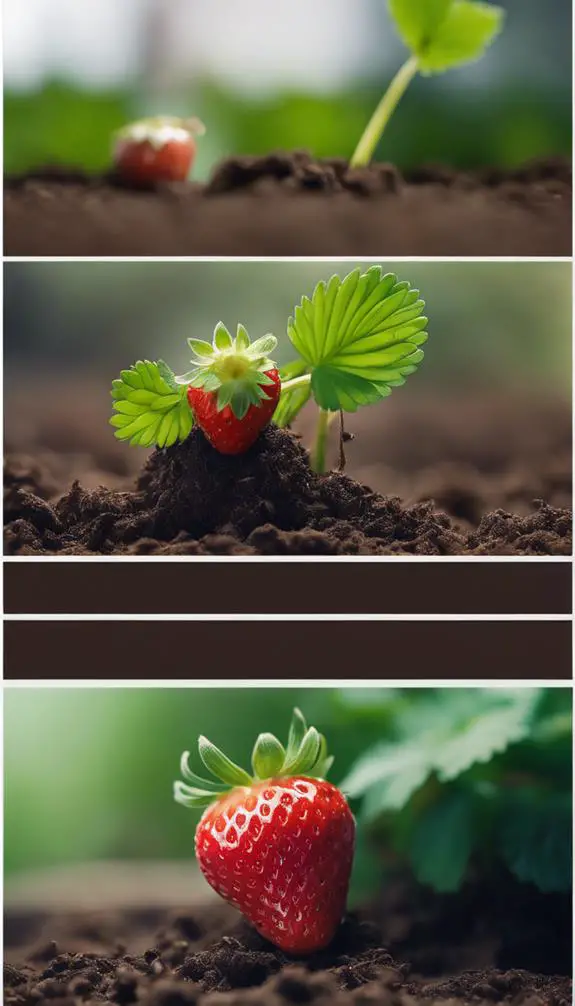You're probably wondering how to turn that juicy strawberry you just devoured into a thriving crop of fresh berries. It's easier than you think! With a few simple steps, you can coax those tiny seeds into producing a bountiful harvest. But first, you'll need to extract and prepare the seeds, then give them the right conditions to germinate. Get it right, and you'll be enjoying sweet, homegrown strawberries in no time. But what's the secret to successful germination, and how can you guarantee your seedlings get the best start in life?
Summary
- Select a strawberry variety suitable for your climate and desired harvest period, such as 'Everbearing' or 'June-bearing'.
- Prepare the seeds by extracting them from the strawberry fruit, rinsing, and drying them to remove excess moisture.
- Germinate the seeds using scarification or stratification, maintaining a consistent temperature and humidity level.
- Plant the seeds 1/8 inch deep in well-draining soil with a pH between 5.5 and 6.5, and water gently but thoroughly.
- Provide optimal growing conditions, including 6-8 hours of direct sunlight, consistent watering, and mulching to retain moisture and suppress weeds.
Choose the Right Strawberry

Selecting the right strawberry variety is crucial for a successful harvest, as different types thrive in distinct conditions and offer varying flavors and textures.
You'll want to ponder factors like climate, soil type, and desired harvest period when making your strawberry selection. For instance, 'Everbearing' strawberry varieties produce multiple harvests throughout the growing season, while 'June-bearing' varieties yield a single large harvest.
If you're looking for a specific flavor profile, 'Albion' strawberries are known for their sweet and tangy taste.
When choosing a strawberry variety, research the specific growing requirements and characteristics to guarantee you're getting the best fit for your garden. This careful selection will pay off in a bountiful and delicious harvest.
Prepare the Seeds
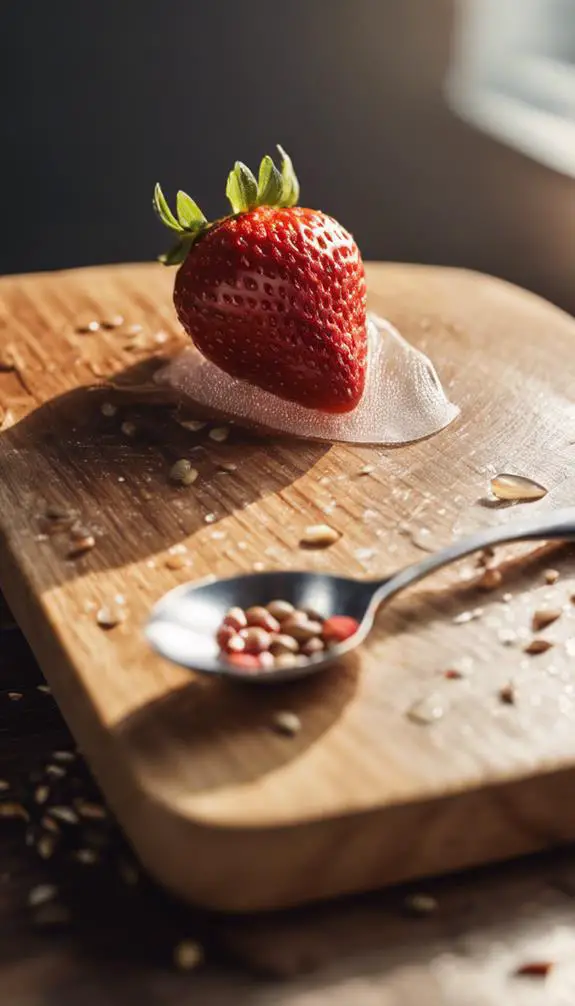
With your strawberry variety chosen, it's time to prepare the seeds for planting.
You'll need to extract the seeds from the strawberry fruit. Cut the strawberry in half and scoop out the seeds with a spoon.
Rinse the seeds gently with water to remove any remaining fruit pulp. Pat the seeds dry with a paper towel to remove excess moisture.
Store the seeds in an airtight container in a cool, dry place for up to 6 months. This is vital for seed storage, as it maintains seed viability.
Verify you're working with fresh seeds for peak germination rates. Now that your seeds are prepared, you're one step closer to growing your own strawberries.
Start Seed Germination
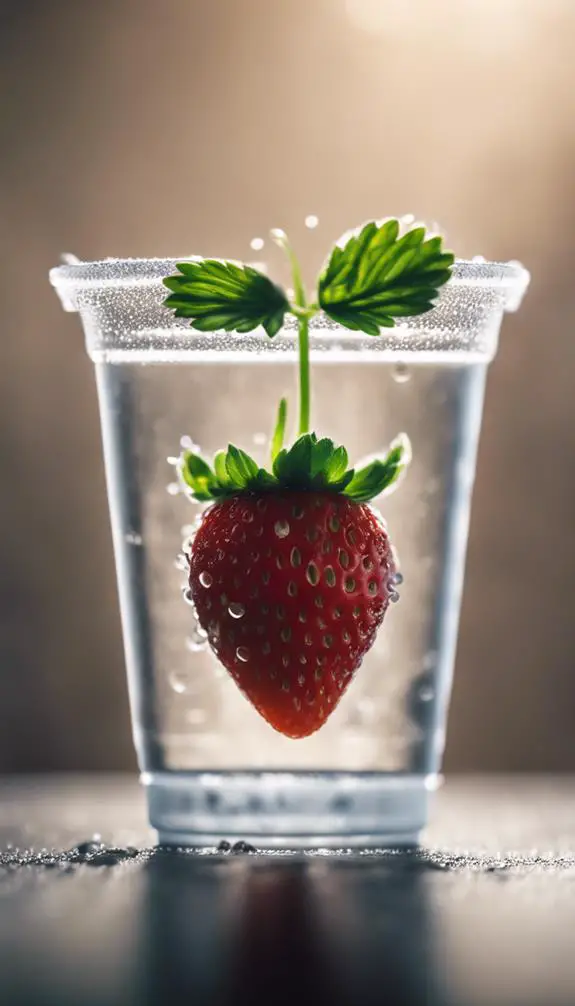
You'll need to prepare your seeds using methods like scarification or stratification to break dormancy.
Next, you'll control the moisture level to guarantee it's consistently between 70% to 90%, as excessive dryness or waterlogging can hinder germination.
Seed Preparation Methods
Prepare your strawberry seeds for germination by scarifying them, a process that breaks down the outer seed coat to facilitate water uptake.
This step is vital for seed viability, as it allows the seed to absorb water and initiate germination. You can scarify your seeds using sandpaper, a file, or even a nail clipper. Make sure to wear gloves to avoid damaging your hands.
Different strawberry varieties may require varying levels of scarification, so research the specific needs of your variety.
Once scarified, soak your seeds in water for 24 hours to rehydrate them. This will help to further break down the seed coat and prepare the seed for germination.
Moisture Level Control
Controlling moisture levels is crucial during strawberry seed germination, as excessive water can cause rot and inadequate water can hinder growth.
You'll want to maintain a delicate balance to guarantee perfect soil hydration. Invest in humidity sensors to monitor the moisture levels in your germination chamber or greenhouse.
These sensors will alert you when the air is too dry or humid, allowing you to make adjustments accordingly. Aim for a relative humidity of 80-90% during the first week, gradually decreasing it to 70-80% as seeds germinate.
Optimal Temperature Range
As you've established the ideal moisture levels for your strawberry seeds, it's now time to focus on the perfect temperature range for germination.
For peak results, you'll want to maintain a consistent temperature between 60°F to 70°F (15°C to 21°C). This range encourages healthy germination and growth.
Be cautious of frost, as temperatures below 40°F (4°C) can hinder germination. Implement frost protection measures, such as using row covers or bringing plants indoors, to guarantee a successful harvest.
Climate control is vital, especially in regions with unpredictable weather patterns. By regulating temperature, you'll create an ideal environment for your strawberry seeds to thrive.
Plant the Seeds Deep

Sowing strawberry seeds at the correct depth is crucial for successful germination and growth.
You'll want to plant them about 1/8 inch deep, as this allows for adequate soil contact while preventing them from being too deeply buried.
When planting, make certain the soil is loose and well-draining to promote healthy root development.
Avoid compacting the soil, as this can hinder soil aeration and impede growth.
Instead, gently firm the soil around the seeds to guarantee good contact.
Provide Adequate Watering
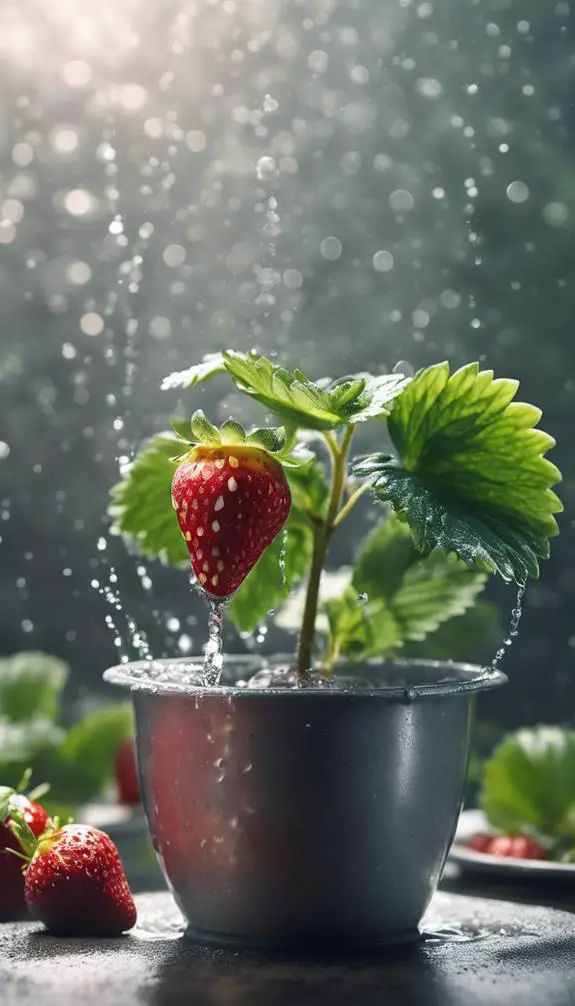
You'll need to establish a consistent watering schedule to guarantee your strawberry plants receive the right amount of moisture.
It's vital to maintain moist soil conditions, as strawberries are highly susceptible to water stress.
Watering Schedule Essentials
With strawberries requiring consistent moisture, particularly during fruiting and flowering stages, establishing a well-planned watering schedule is crucial for peak growth and yield.
You'll want to water your strawberries when the top 1-2 inches of soil feel dry to the touch. Aim to provide about 1 inch of water per week, either through rainfall or irrigation.
To optimize soil hydration, water your strawberries in the morning to allow for maximum water absorption throughout the day. Avoid overhead watering, which can promote fungal diseases.
Instead, use soaker hoses or drip irrigation to deliver water directly to the roots. By sticking to a consistent watering schedule, you'll guarantee your strawberries receive the right amount of moisture to thrive.
Moist Soil Conditions
Maintaining moist soil conditions is essential for strawberry plants to thrive, as they require consistent hydration to produce healthy fruit and foliage.
You'll want to guarantee the soil is consistently moist but not waterlogged, as this can lead to root rot. Check the soil daily, and water when the top inch of soil feels dry.
Avoid overwatering, which can reduce soil aeration and hinder root growth. Fine-tune soil pH between 5.5 and 6.5, as strawberries prefer slightly acidic to neutral soil.
Mulching around the plants can help retain moisture and regulate soil temperature. By providing adequate watering and maintaining ideal soil conditions, you'll be on your way to growing healthy, productive strawberry plants.
Water Quality Matters
Strawberry plants crave water that's free from contaminants and excessive mineral buildup, as these can hinder their growth and fruit production.
You'll want to guarantee the water you're using is of high quality. Conduct regular water testing to check for pH levels, nutrients, and contaminants. This will help you identify any issues that might affect aquatic health.
If you're using tap water, consider investing in a water filtration system to remove impurities. Rainwater or distilled water are also good options.
Aim to provide your strawberry plants with consistent moisture, but avoid overwatering, which can lead to root rot and other problems. By prioritizing water quality, you'll be giving your strawberries the best chance to thrive.
Ensure Proper Lighting
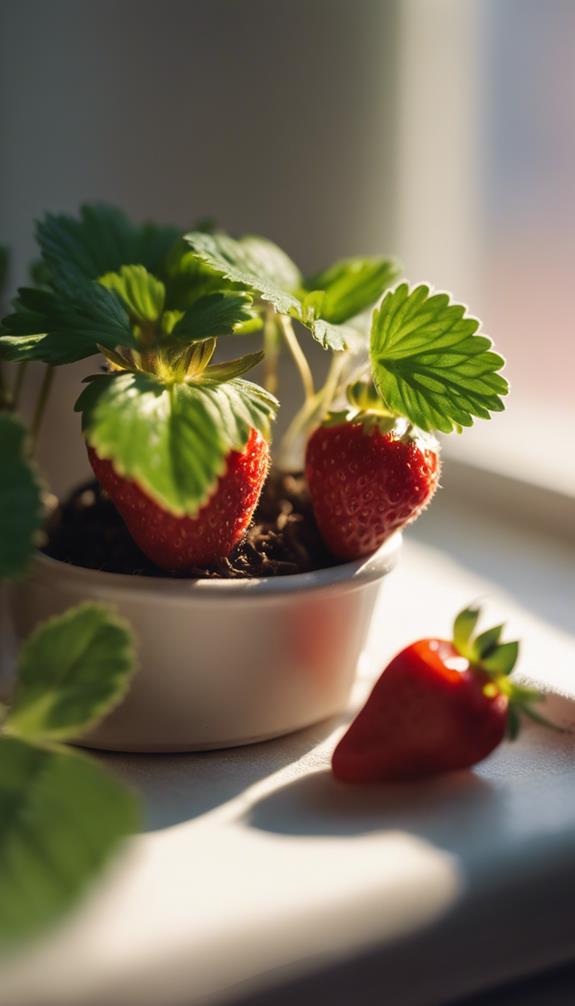
By virtue of their photosynthetic nature, strawberries require a significant amount of light to thrive.
You'll need to guarantee your strawberry plants receive sufficient sunlight hours, ideally 6-8 hours of direct sunlight per day.
If natural light is limited, consider supplementing with artificial lighting.
LED grow lights or fluorescent lights can provide the necessary spectrum and intensity for peak growth.
Position lights 6-8 inches above the plants, and adjust as they grow.
Be mindful of light duration, as excessive exposure can lead to scorching.
Aim for a balanced lighting schedule, and monitor your plants' response to adjust accordingly.
Proper lighting will promote healthy growth, fruiting, and overall plant development.
Maintain Optimal Temperature
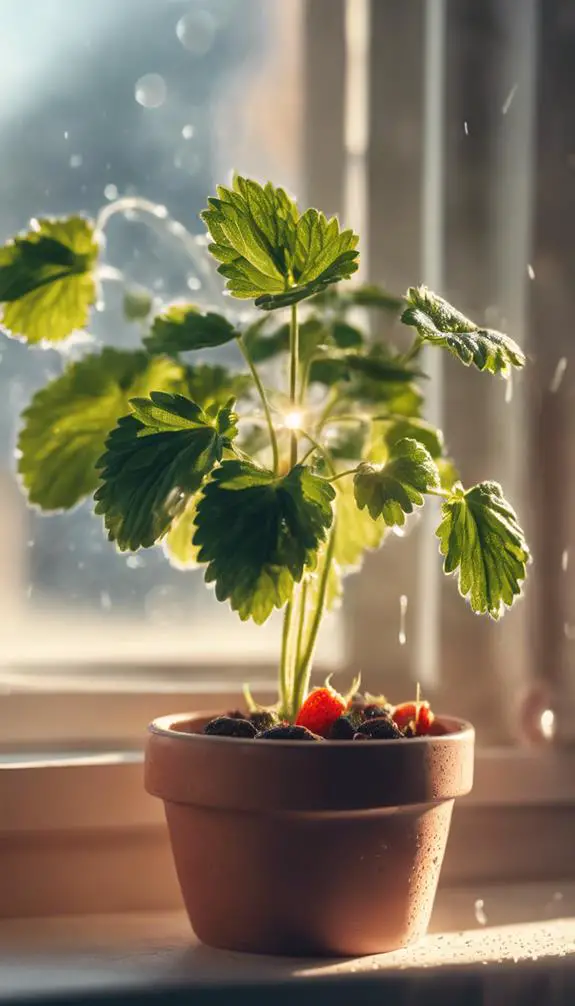
You'll want to maintain an ideal soil temperature between 60°F and 70°F (15°C and 21°C) for peak strawberry growth, as this range promotes healthy root development.
Additionally, strawberries benefit from cooler night temperatures, which help regulate their metabolic processes and prevent stress.
Ideal Soil Temperature
When planting strawberries, getting the soil temperature just right is crucial for ideal growth, as it directly affects root development and nutrient uptake.
You want the soil to be between 60°F to 70°F (15°C to 21°C) for peak growth. This temperature range allows for healthy root development, which is essential for the strawberry plant's overall health.
Guarantee your soil structure is well-draining and has a pH between 5.5 and 6.5. At this ideal pH, your strawberries will be able to absorb the necessary nutrients for growth.
Cooler Night Temperatures
While achieving ideal soil temperature is vital, it's equally important to maintain cooler night temperatures to promote healthy strawberry growth.
You'll want to guarantee your strawberry plants experience temperatures between 40°F and 50°F (4°C and 10°C) during the night. This temperature range simulates the natural environment found in cooler climates, where strawberries thrive.
Frosty nights, in particular, stimulate the plant's natural response to cold stress, triggering the production of antioxidants and sugars.
By maintaining cooler night temperatures, you'll encourage your strawberries to develop a stronger root system, produce more flowers, and yield sweeter fruit.
Monitor your nighttime temperatures closely to provide your strawberries with the perfect conditions for growth and development.
Fertilize the Soil
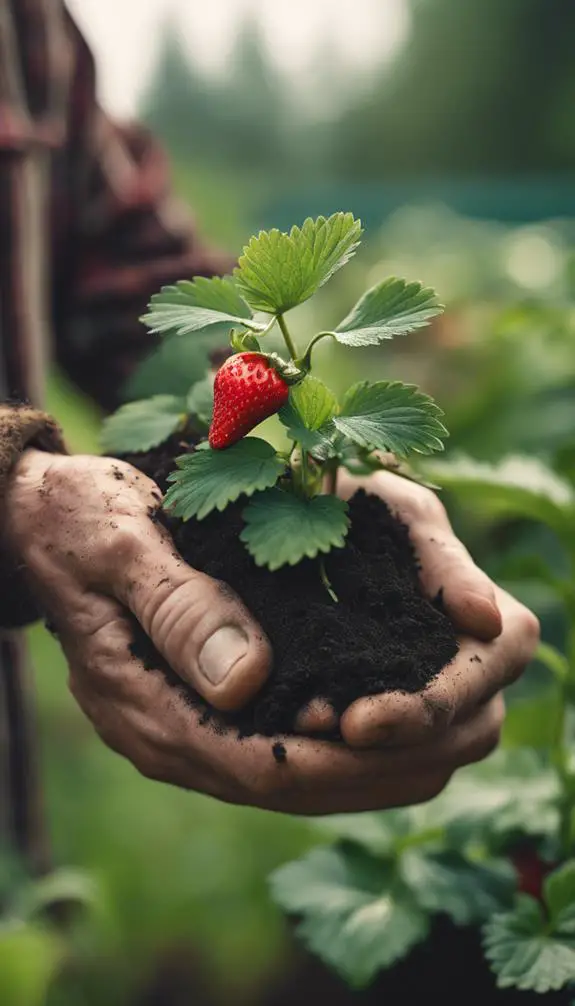
Strawberry soil preparation involves a mix of organic matter and fertilizer to create a nutrient-dense growing environment.
You'll want to test your soil's pH level to guarantee it's between 5.5 and 6.5, as strawberries prefer slightly acidic soil. If your soil is too alkaline, add peat moss or sulfur to lower the pH.
Add a 2-inch layer of organic matter like compost, well-rotted manure, or leaf mold to improve soil structure and fertility. This will provide essential nutrients for your strawberries to thrive.
Avoid over-fertilizing, as this can damage your plants. Instead, use a balanced fertilizer with a ratio of 10-10-10 (nitrogen-phosphorus-potassium) and follow the manufacturer's instructions for application rates.
Transplant Seedlings Outdoors

You've prepared your soil, and now it's time to transplant your strawberry seedlings outdoors.
Before moving them, verify they're ready for outdoor acclimation by hardening off. This process involves gradually exposing the seedlings to outdoor conditions over 7-10 days.
Start by moving them to a shaded area outdoors for 1-2 hours, then return them to their indoor spot. Gradually increase the duration and intensity of outdoor exposure, monitoring for signs of stress.
Once they can tolerate full sun and wind, it's time to transplant. Dig holes 12-18 inches apart, and gently place the seedlings at the same depth as their pots.
Water thoroughly, and mulch around the plants to retain moisture and suppress weeds.
Space Plants Correctly
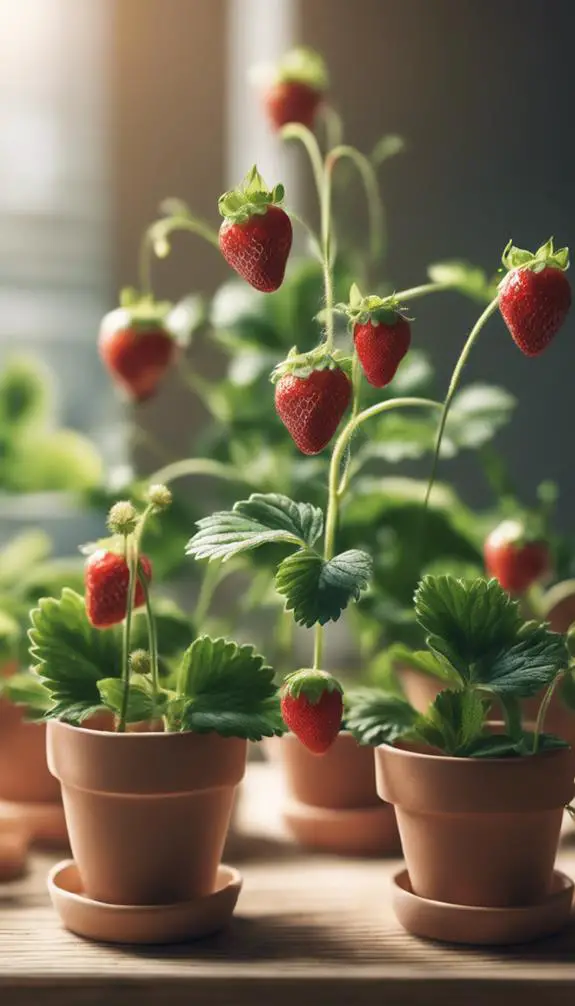
Proper spacing is crucial for ideal strawberry growth and fruit production. You'll want to space your plants correctly to guarantee each strawberry plant receives adequate sunlight, air circulation, and water.
In your garden layout, aim for a spacing of 12-18 inches between each plant, with rows spaced 3-4 feet apart. This row spacing allows for easy access when harvesting and maintaining your strawberry bed.
Make sure to plant them in a way that the crown (where the roots and leaves meet) is at soil level, and water well after transplanting. By spacing your plants correctly, you'll promote healthy growth, increase fruit production, and reduce the risk of disease spreading between plants.
Mulch Around the Plants
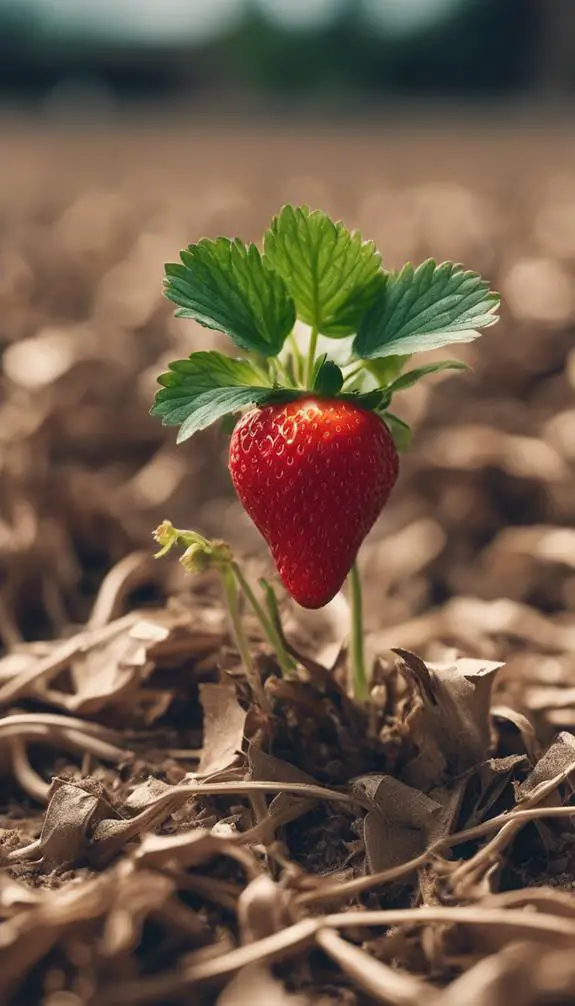
Settle the soil around your transplanted strawberries by applying a 2- to 3-inch layer of organic mulch.
This strawberry insulation helps retain moisture, suppress weeds, and regulate soil temperature. As a result, your strawberries will receive the ideal conditions for growth.
You'll notice mulch benefits such as improved fruit quality and increased yields. Organic mulch options like straw, bark chips, or grass clippings work well.
Avoid using mulch with weed seeds, as they can compete with your strawberries. Keep the mulch a few inches away from the plant crowns to prevent rot.
As the mulch breaks down, it will add nutrients to the soil, creating a healthy environment for your strawberries to thrive.
Monitor for Pests

As your strawberry plants flourish, they'll inevitably attract unwanted visitors.
It's vital to monitor for pests regularly to prevent damage. Inspect your plants for signs of infestation, such as holes, discoloration, or actual pests. Identify the pests to determine the best course of action.
Common strawberry pests include aphids, slugs, and spider mites. Use natural repellents like neem oil, garlic spray, or predator insects to control infestations.
Introduce beneficial insects like ladybugs or lacewings, which prey on strawberry pests.
Create a pest-repellent environment by maintaining good garden hygiene, removing weeds, and ensuring proper air circulation.
Enjoy Your Harvest

By the time your strawberry plants are laden with juicy red fruit, you'll be enthusiastic to start enjoying the fruits of your labor.
This is crucial to harvest your strawberries at the right time to guarantee prime flavor and texture. Check your plants daily, as strawberries are highly perishable and spoil quickly.
Gently grasp the fruit and twist it to release it from the stem. Harvest your strawberries in the early morning, when they're typically at their sweetest.
Enjoy your Fresh Harvest by consuming them immediately or storing them in the refrigerator for up to three days. Savor your Berry Delights in salads, smoothies, or as a sweet snack.
FAQs
Can I Grow Strawberries From Store-Bought Strawberries?
You can try growing strawberries from store-bought ones, but chances are low since they're often hybrids or treated to prevent sprouting; instead, opt for fresh seeds or a ripe selection from a nursery or gardening store for better success.
How Long Does It Take for Strawberries to Produce Fruit?
When cultivating strawberries, you'll wait around 60-90 days for fruit production, with peak yield typically occurring 120-180 days after planting, depending on factors like climate, soil quality, and specific strawberry variety, setting realistic fruit production timeline and yield expectations.
Can I Grow Strawberries in a Container or Indoor Pot?
You can successfully grow strawberries in a container or indoor pot by using well-draining potted soil and controlling the indoor climate, maintaining a consistent temperature between 60-70°F and ensuring 6-8 hours of indirect sunlight daily.
Do I Need to Prune Strawberry Plants Regularly?
You'll need to prune your strawberry plants regularly to promote healthy growth and maximize yields; master strawberry maintenance by learning precise pruning techniques, such as pinching and removing runners, to optimize fruit production and plant vigor.
Are Strawberry Plants Susceptible to Diseases Like Fungal Infections?
You'll find that strawberry plants are indeed susceptible to diseases like fungal infections, but you can mitigate this by selecting varieties with built-in fungal resistance and maintaining ideal soil quality through proper pH management and organic matter incorporation.
Conclusion
You've successfully grown strawberries from a strawberry! Now, maintain your plants' health by monitoring for pests and diseases. Fertilize them regularly, and divide overcrowded plants to promote healthy growth. With proper care, you'll enjoy a bountiful harvest of juicy strawberries. Remember to store any leftover seeds in an airtight container for future use.


